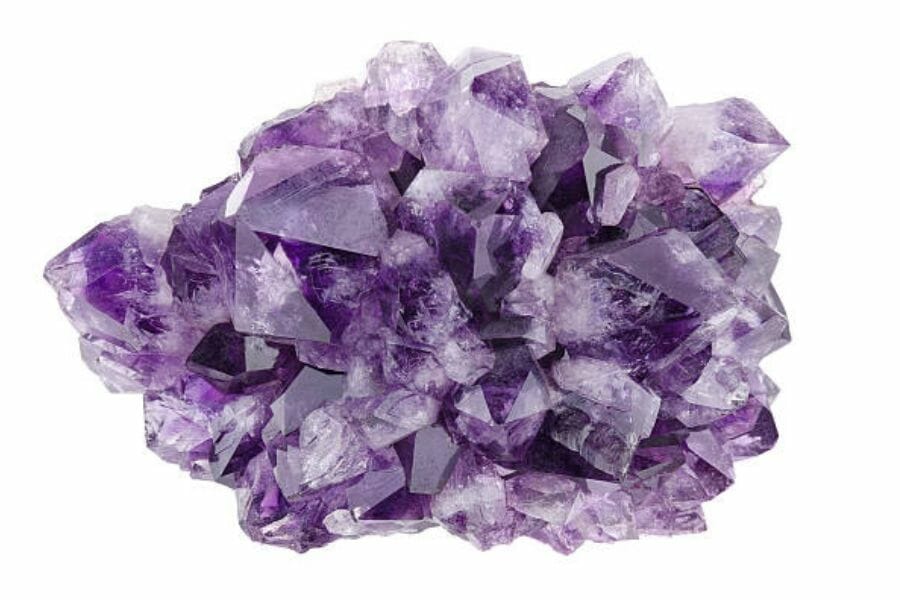Purple rocks, minerals, and gems are some of the world’s most beautiful and captivating natural phenomena. The color purple is associated with royalty, luxury, and mystery, which makes these objects even more intriguing.
Purple rocks, minerals, and gems can be found in many places worldwide and come in various shapes, sizes, and colors. They can range from deep purples to light lavenders to vivid magentas.
Purple rocks are usually igneous or metamorphic in origin. These rocks often contain trace amounts of minerals that give them their distinct purple hue.
The wide range of purple rocks, minerals, and gems makes them sought after by collectors and enthusiasts. These objects can be used to create stunning jewelry or admired for their unique beauty.
This article will explore the different types of purple rocks, minerals, and gems so you can be even more fascinated!
Purple Gems
Some of the world’s most gorgeous and captivating purple gemstones include the following:
Amethyst – SiO2
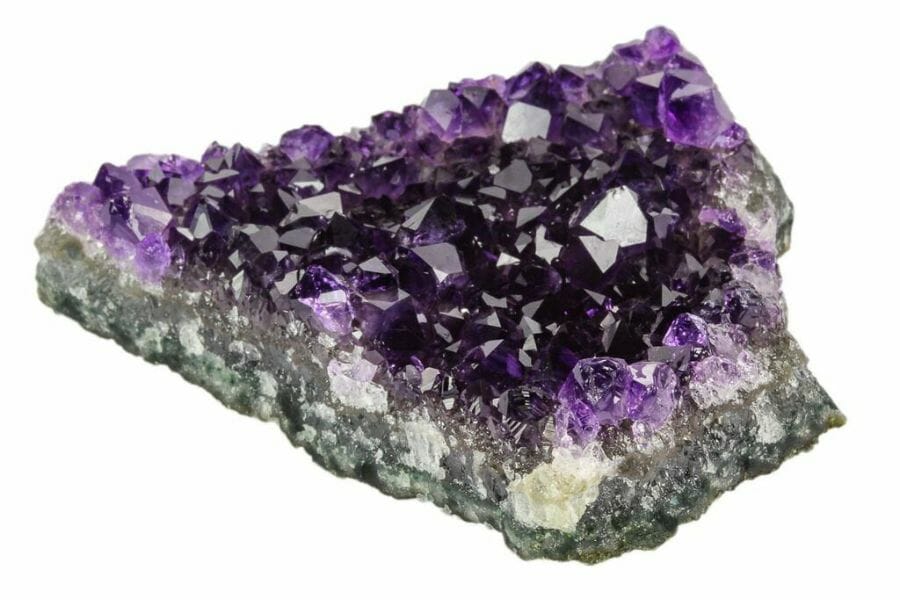
Amethyst is a beautiful, semi-precious gemstone prized for its deep purple hues and unique characteristics. Most likely, it’s the first of the purple crystals that you think of.
It belongs to the quartz family and is often associated with royalty, wealth, and spirituality. Amethyst has been used in jewelry and artwork since ancient times, with some of the oldest known specimens originating in Egypt around 2000 BC.
It was believed to be a powerful symbol of protection against the drunkenness of the ancient Greeks and Romans. Amethyst has been used as a talisman to ward off negative energy, illness, and misfortune.
It has also been known to enhance intuition and spiritual awareness. Amethyst is still highly sought after for its beauty and metaphysical properties.
Fun Fact
Amethyst is the traditional birthstone for February, and is also the official state gemstone of South Carolina.Where Amethysts are found
Amethysts can be found in various locations, including Brazil, Uruguay, Russia, Zambia, and Afghanistan. Some of Brazil’s largest and finest amethyst deposits are found in Minas Gerais and Bahia.
In Russia, the Ural Mountains have produced exceptional amethysts for centuries, while Zambia is known for producing deep, rich purple specimens.
Other significant sources of amethyst include Madagascar, Bolivia, and Peru. Amethysts can also be found in smaller deposits in several other countries, including the United States, South Korea, and Scotland.
How you can identify an Amethyst
Color
Amethyst is often found in shades of deep purple. Its unique color is due to the presence of iron and aluminum within the crystal structure, which creates a vibrant, royal hue.
The intensity of the color can range from pale lavender to dark violet, with subtle flashes of red and blue.
Hardness
Amethyst is considered a relatively hard gemstone, with a hardness rating of 7 on the Mohs scale. This means that it is harder than most other common stones, such as talc and gypsum, but softer than durable materials like corundum and diamond.
Amethyst can withstand daily wear and tear without easily scratching or breaking. It can also resist mild acids and hot temperatures with minimal damage.
Clarity
Amethyst is a beautiful gemstone that has excellent clarity. It has a high level of transparency and can be seen clearly, with no visible inclusions or flaws. Its clarity is often described as “diamond-like” due to its sparkle and brilliance when cut.
Refractive index
The refractive index of Amethyst ranges from 1.544 to 1.553, which measures how much light is bent when passing through a gemstone.
This bending of light causes the gemstone to have a certain degree of optical dispersion, or “fire,” which is seen as the separation of light into its component colors.
Specific gravity
The specific gravity of Amethyst is 2.65, meaning it is 2.65 times heavier than an equal volume of water. This makes amethyst a relatively dense gemstone, and it can be used to distinguish amethyst from other gemstones due to its weight.
Ametrine – SiO2
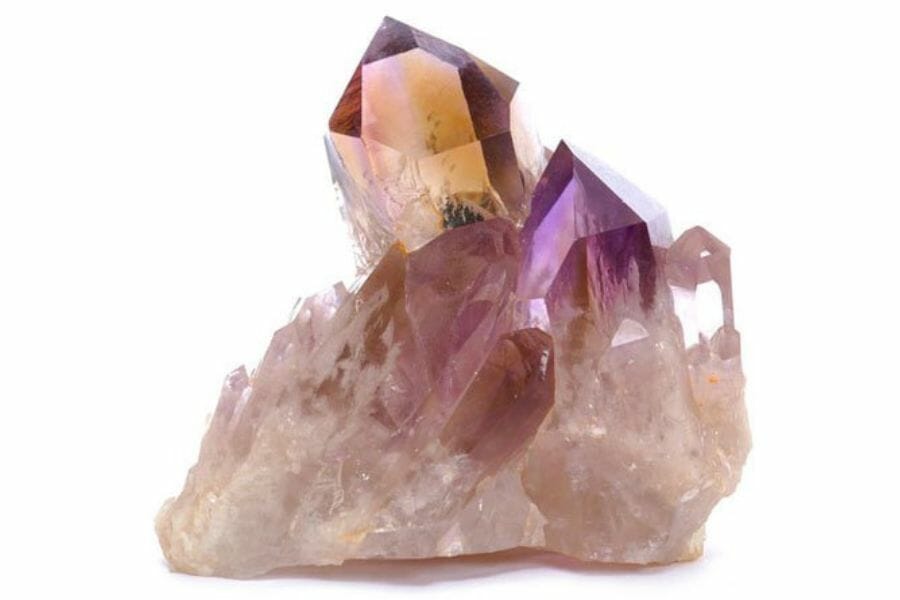
Ametrine is a beautiful and unique gemstone that is a combination of both amethyst and citrine. It was discovered in the 17th century in the Anahi Mine in Bolivia, South America.
Due to its dual-colored appearance, the gemstone has been used for centuries as a symbol of balance, harmony, and unity.
Ametrine has an intense golden-yellow hue combined with a deep purple color that can be seen when cut into facets. It is also believed to be a stone of spiritual growth and enlightenment, helping people better understand their true selves.
This beautiful stone can still be found in jewelry worldwide as it continues to captivate people with its unique beauty.
Fun Fact
Did you know? Ametrine is the only gemstone in the world that naturally occurs with two distinct colors: purple and yellow. Such a unique gem!Where Ametrines are found
Ametrine is primarily found in the Anahi Mine in the Bolivian Andes. It is the only known source of naturally occurring ametrine, making it a rare gemstone.
However, ametrine is also found in smaller deposits in other countries, such as Brazil, Argentina, and Zambia.
How you can identify an Ametrine
Color
Ametrine is a unique gemstone with a striking contrast of colors. It has a warm, golden-yellow hue and a cool, bluish-violet hue that swirls together in one beautiful stone.
The variegated pattern of both colors creates a stunning visual effect that will draw attention. Its color palette makes it an ideal stone for anyone who desires something unique and eye-catching.
Hardness
Ametrine has a hardness of 7 on the Mohs scale, which means it’s quite durable and resistant to scratches and abrasions.
Although it isn’t as tough as some other gemstones like sapphires or diamonds, it’s still relatively stable and can survive normal wear and tear.
Clarity
Ametrine has a vitreous luster, with the two colors often blending in an eye-catching pattern. Typically, it has good clarity with few visible inclusions. When cut properly, it can show off its intense colors and attractive patterning to a significant effect.
Refractive index
Ametrine has a refractive index of 1.544-1.553, slightly lower than amethyst (1.554-1.556) and citrine (1.544-1.553).
This slightly lower refractive index can cause the colors of ametrine to appear more muted than those of either amethyst or citrine alone, as light is less effectively bent when passing through the stone.
Specific gravity
Ametrine has a specific gravity of 2.65-2.66, slightly higher than quartz (2.6-2.7). It’s a moderately dense gemstone but not as dense as sapphire or ruby (3.95-4.03).
It has similar physical properties to quartz but with a slightly higher density due to the presence of iron in both minerals.
Iolite – Mg2Al4Si5O18
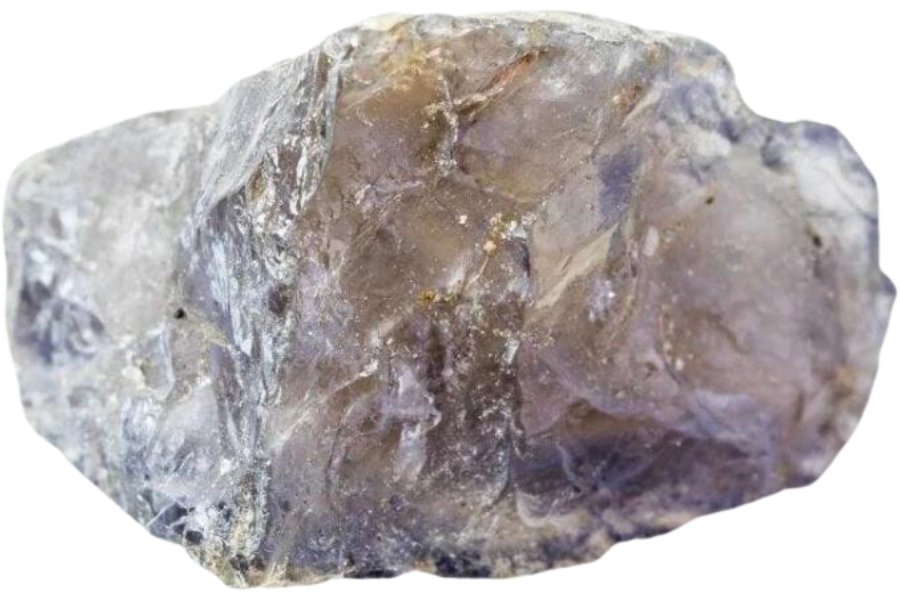
Iolite is a transparent, gemstone-quality mineral composed of magnesium aluminum silicate. It is known for its blue-to-violet hue, which is caused by iron and manganese.
It has been used as a gemstone since ancient times, with examples found in Greece and Rome.
Iolite is still frequently used in ornamental objects and jewelry today, including pendants, rings, and earrings. It can also be polished into unusual forms or cut into cabochons for a more ornamental appearance.
Fun Fact The Vikings were known to use iolites as a navigation tool due to its ability to polarize light and show them the sun's location when no stars or landmarks were visible.
Where Iolites are found
Iolite can be found in various locations, including Madagascar, India, Sri Lanka, Tanzania, Mozambique, and the United States.
The most notable deposit is in Sri Lanka, where the gemstone is mined for its use in jewelry and ornamental purposes. The availability of iolite can vary depending on the location.
How you can identify an Iolite
Color
Iolite is a beautiful gemstone with an intense and deep color. It ranges from violet-blue to pale blue-gray, often with a hint of yellow.
The most valued color is a strong, deep blue reminiscent of sapphire. Its unique hue can be described as a blend between sapphire and tanzanite.
Hardness
Iolite has a hardness of 7 to 7.5 on the Mohs scale, which measures a mineral’s resistance to scratching. It’s suitable for everyday use in jewelry due to its hardness.
While it’s not as hard as some other well-known gemstones, such as sapphire or ruby, it’s still tough enough to survive everyday wear and tear.
Clarity
Iolite has a vitreous luster, which gives it a glassy appearance when cut and polished. It is usually transparent to translucent, with good clarity that can be seen through the gemstone.
Refractive index
Iolite has a refractive index of 1.52-1.55, depending on the direction of the light passing through it. It is higher than quartz but lower than diamond.
Specific gravity
Iolite has a specific gravity of 2.58-2.72, slightly higher than the average gemstone. It has a lower density than quartz and topaz but is still relatively dense for a gemstone. Its specific gravity makes it heavier than many other stones.
Kunzite – LiAl(SiO3)2
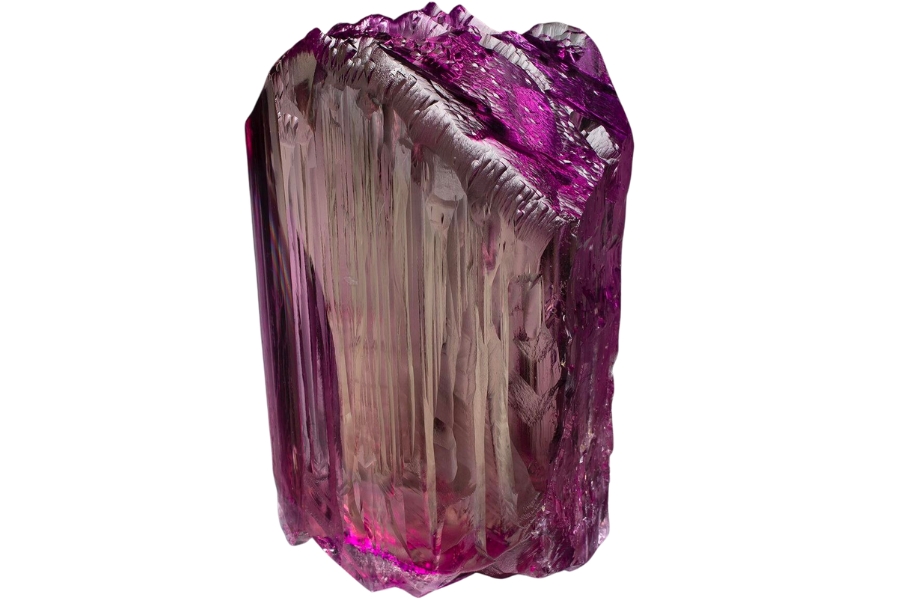
Kunzite is a variety of the mineral spodumene, a pyroxene group silicate mineral. It was first discovered in 1902 by George Kunz, a gemologist for Tiffany & Co., and was named after him.
Kunzite is known for its beautiful pink to lavender hues and can also be found in shades of green, yellow, orange, and colorless.
The largest source of kunzite is Brazil, but it can also be found in Afghanistan, Madagascar, Mozambique, Namibia, Pakistan, Tanzania, and the United States.
It has been used in jewelry since its discovery due to its beautiful color tones, making it one of the most popular gemstones today.
Fun Fact
Kunzite typically disappears in sunlight. Because of this, Kunzite is also known as the "evening gemstone."Where Kunzites are found
Kunzite is found in several countries worldwide, including Afghanistan, Brazil, Madagascar, Mexico, and the United States.
The finest kunzite specimens are typically found in Afghanistan, Pakistan, and Madagascar, where it occurs in large, gem-quality stones. In the United States, kunzite is found in California and New Mexico.
In Brazil, it is found in Minas Gerais and Bahia. The occurrence of kunzite is not widespread and is considered a relatively rare gemstone, contributing to its high value in the market.
How you can identify a Kunzite
Color
Kunzite is a beautiful light pink to lavender stone that can sometimes be found with a slightly bluish hue. Its delicate color is often described as reminiscent of the soft hues of twilight or gentle spring rain.
Hardness
Kunzite is a relatively soft gemstone with a Mohs hardness of 6 to 7. It is less complex than quartz, with a scratch resistance that is similar to that of topaz.
It can be scratched and chipped more quickly than other gems, so care should be taken when wearing or cleaning this gemstone.
Clarity
Kunzite is known for its clarity, which ranges from transparent to translucent. Its clarity is often described as being diamond-like due to its ability to refract light and sparkle in the sun.
It has a vitreous luster, which gives it a smooth, glassy appearance.
Refractive index
The refractive index of Kunzite ranges from 1.6 to 1.7, making it a relatively refractive gemstone.
Specific gravity
Kunzite has a specific gravity of 2.75-3.00, making it one of the denser gemstones. This is due to its higher refractive index and birefringence than other minerals, which contributes to its heavier weight.
Purple Rocks
The following is a list of some of the most amazing purple rocks ever found:
Indigo Gabbro – (Na,Ca)[(Si,Al)AlSi2]O8
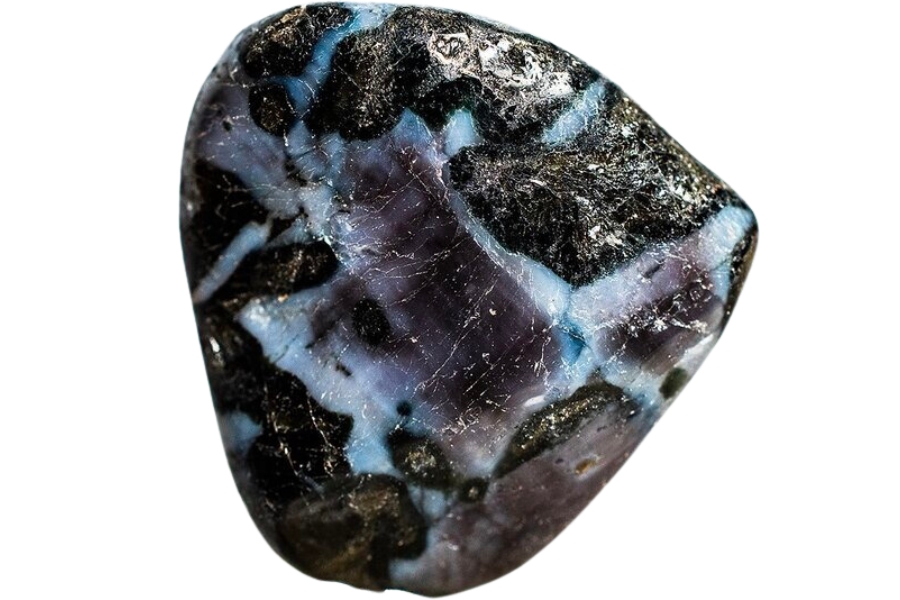
Indigo Gabbro is composed of pyroxene, plagioclase, and olivine. Its unique color results from trace amounts of titanium and chromium within its structure. The name “Indigo Gabbro” is derived from its distinctive deep blue-purple hue.
Indigo Gabbro is an exciting rock that fascinates collectors with its unique coloring and composition. With its increasing availability, it will remain a favorite among those who have appreciated rare rocks for many years.
Fun Fact Indigo Gabbro is also called "mystic merlinite." The term "mystic merlinite" refers to both the similarity of the stone to merlinite, and the legendary magician, Merlin.
Where Indigo Gabbros are found
The first discovery of Indigo Gabbro was made in 1845 in a remote area of Norway. Since then, it has been found in various locations, including Madagascar, Australia, Pakistan, Brazil, the United States, and Canada.
How you can identify an Indigo Gabbro
Color
Indigo Gabbro is a dark, deep bluish-purple stone. It has a unique color that is both mysterious and captivating. It is composed of black, gray, and blue minerals such as olivine and pyroxene, giving it its subtle yet vibrant hue.
Hardness
Indigo Gabbro is generally considered to have a hardness of 6-7 on the Mohs scale. It is a relatively hard rock, being harder than glass and softer than quartz. It can be scratched with a steel nail but not with a copper penny.
Clarity
Indigo Gabbro is a coarse-grained, intrusive igneous rock (in other words, cooled lava or magma!) with interlocking crystals of plagioclase feldspar and pyroxene.
The mineral grains in Indigo Gabbro are visible to the naked eye, resulting in clarity that allows its components to be easily identified.
Refractive index
Indigo Gabbro has a refractive index of 1.56-1.57, which is relatively high compared to other rocks and is slightly higher than the average refractive index of 1.54 for most igneous rocks.
Specific gravity
Indigo Gabbro has a specific gravity of 3.00-3.05, which is relatively high compared to other igneous rocks.
This indicates that the rock comprises minerals with a higher density than average, such as olivine and pyroxene, which comprise most of its composition.
As a result, Indigo Gabbro is heavier than other igneous rocks with similar-sized stones and grains.
Lepidolite – K(Li,Al) 3(Al,Si,Rb) 4O 10(F,OH) 2
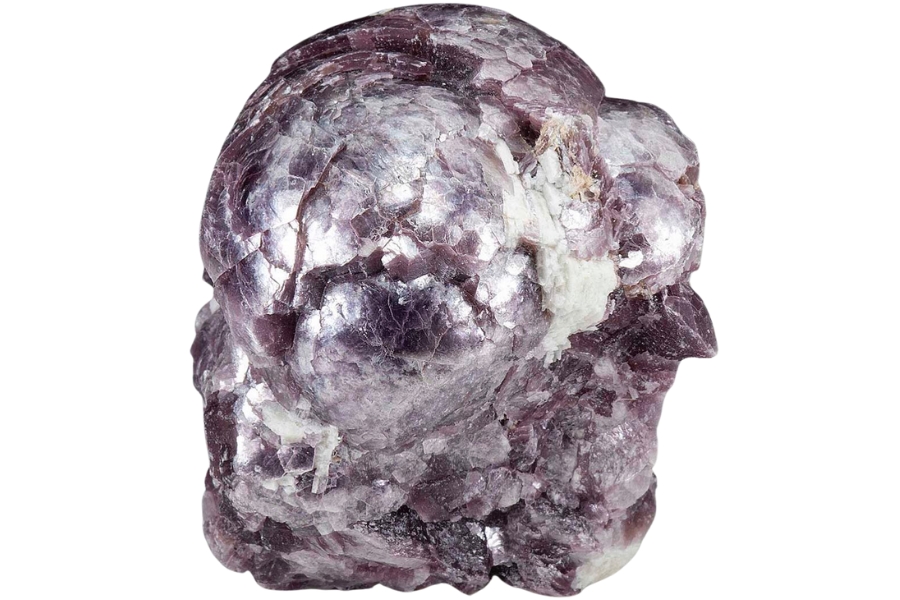
Lepidolite is a lithium-rich rock that belongs to the mica group of minerals. The first recorded mention of lepidolite was in 1792 by Abraham Gottlob Werner in his book Mineralogische Beyträge zur Naturgeschichte.
It has since been used as a source of lithium, which has a wide range of applications, including in batteries, ceramics, and glass production.
Lepidolite is typically found in granite and pegmatite formations and is commonly recognized for its lilac, pink, or rose color and delicate sheet-like structure. It has also been used in jewelry as a decorative, traditional medicine, and spiritual stone.
Fun Fact
Lepidolite is named after the Greek word lepidion, which means “scale” and lithos , which means “stone.”Where Lepidolites are found
Lepidolite can be found in various locations, including Brazil, Madagascar, the United States, Russia, and several other countries.
Some of the most significant deposits of lepidolite have been found in pegmatite formations, which are coarse-grained intrusive igneous rocks.
In these formations, lepidolite occurs as masses, sheets, or veins associated with other minerals such as quartz, feldspar, and beryl.
Lepidolite can also be found in lithium-rich mica schist and lithium-bearing pegmatite-related lithium metasomatism.
How you can identify a Lepidolite
Color
Lepidolite is a lavender-gray to pinkish-purple mica, often with a lilac sheen. It has a delicate, soft hue that is calming and soothing to the eye. Its color can range from light to dark purple and may contain quartz or tourmaline inclusions.
Hardness
Lepidolite is a soft to medium hardness mineral on the Mohs scale, ranging from 2.5 to 3. It has a slightly greasy feel and can be scratched with a fingernail. Lepidolite is brittle and breaks easily, with a conchoidal fracture pattern.
Clarity
Lepidolite has a vitreous luster, and the cleavage planes are often visible. Its transparency ranges from transparent to translucent, and its clarity can be affected by the inclusions of other minerals and fractures within its structure.
Refractive index
Lepidolite has a refractive index between 1.524 and 1.556, depending on the direction of the light source.
It has a biaxial negative optical character, meaning it will bend light in two directions, and its polarizing properties are more potent when viewed from certain angles.
Specific gravity
Lepidolite has a specific gravity of between 2.8 and 3.1, depending on the sample. Its low specific gravity means that lepidolite can be easily manipulated by hand, making it an excellent choice for carvings and sculptures.
Purple Minerals
Here is a list of the rarest purple minerals that exist:
Bertrandite – Be₄Si₂O₇(OH)₂
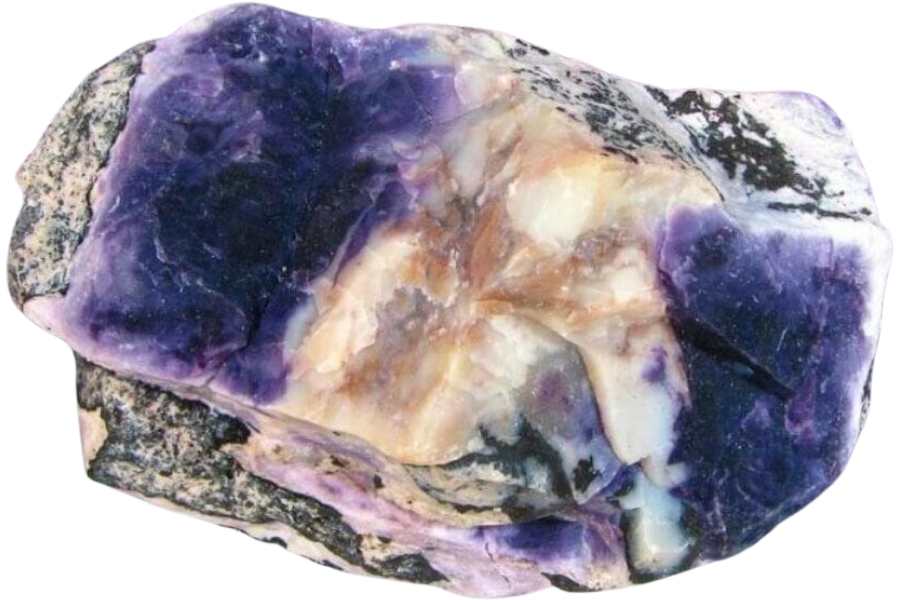
Bertrandite is extremely rare and has been highly sought after by collectors for centuries. It is a hydrated beryllium silicate mineral.
It was first discovered in France, and since then, it has been found in various locations worldwide, including Madagascar, New South Wales, California, and Oregon.
The demand for bertrandite has been increasing as the demand for beryllium-based products grows, making it a valuable commodity in the mineral market.
Despite its importance, bertrandite is a relatively unknown mineral, and its extraction and processing pose challenges due to its scarcity and potential environmental and health hazards associated with beryllium exposure.
Fun Fact
Bertrandites are widely used in the production of beryllium metal and its alloys, which are critical components in many high-tech industries, such as aerospace and electronics.Where Bertrandites are found
Bertrandite can typically be found in regions of the western United States, specifically in Utah, Nevada, and Oregon. Other countries where bertrandite is found include France, China, Brazil, and Turkey.
How you can identify a Bertrandite
Color
Bertrandite is a rare mineral with a soft and delicate hue. Its color ranges from light lilac to deep violet and has a bluish tinge.
The color of purple bertrandite is unique and can range from pale lavender to deep mauve. Its shade often displays slight variations, giving it an exciting and complex look.
Hardness
Bertrandite is a fairly hard mineral, with a Mohs hardness of 6.5 to 7. Its hardness falls between that of quartz and orthoclase feldspar.
While it’s not as hard as some other minerals, such as topaz or diamond, it’s still quite durable and can be used in jewelry and other decorative objects.
Clarity
Bertrandite is a mineral with good clarity and transparency, with occasional inclusions or cloudiness present. Its transparency can range from translucent to nearly transparent, depending on the quality of the specimen.
Refractive index
The refractive index of bertrandite is 1.522-1.524, which is relatively low compared to other minerals such as quartz. It has a uniaxial refractive index with a biaxial negative optical orientation.
The birefringence of bertrandite is also low, ranging from 0.006 to 0.008, and its dispersion is weak.
Specific gravity
The specific gravity of bertrandite ranges from 2.9 to 3.1, making it a relatively dense mineral. It is heavier than quartz and other common minerals but lighter than most other beryllium-bearing minerals, such as beryl and chrysoberyl.
Chambersite – Mn₃B₇O₁₃Cl
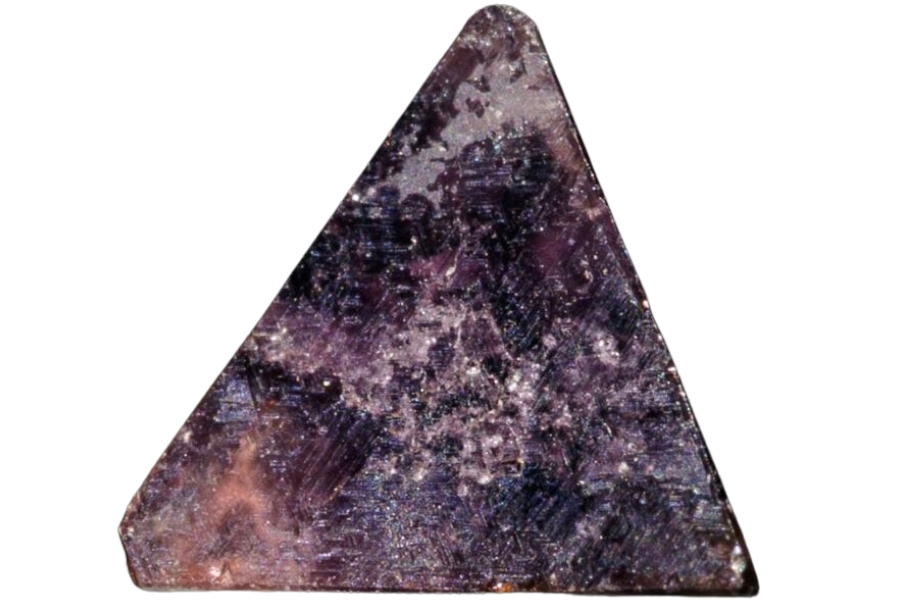
Chambersite is a rare mineral discovered in 1891 at the Little Annie Mine in Colorado, USA. It’s a lead-antimony sulfosalt and belongs to the tetrahedrite group of minerals.
It is known for its striking combination of silver-gray color and metallic luster, making it a sought-after mineral for collectors.
Despite its initial discovery over a century ago, chambersite remains a rare mineral and is only found in a few locations worldwide, including the USA, Mexico, and China.
Its scarcity and unique characteristics have made it a valuable addition to mineral collections and have earned it a place among the world’s most exciting and notable minerals.
Fun Fact
Chambersite was named after American mineralogist John H. Chambers.Where Chambersites are found
Chambersites can be found in various locations worldwide, including the United States, Canada, Australia, and Europe.
How you can identify a Chambersite
Color
Chambersite is a mineral with a colorless to deep purple color. Chambersite often contains red and orange inclusions, which can add to its unique coloration.
Hardness
Chambersite is a hard mineral with a hardness of 6 on the Mohs scale. It’s harder than most common minerals and will not be scratched by a knife blade. It is also resistant to many acids but can be dissolved in hydrochloric acid.
Chambersite has an even conchoidal fracture when broken and can be found in some metamorphic rocks.
Clarity
Chambersite is transparent to translucent, with a vitreous luster and good clarity. It often has some inclusions, but these are usually not visible to the naked eye. It can also show chatoyancy or adularescence, depending on how it is cut.
Refractive index
The refractive index of chambersite is 1.567-1.723, with a birefringence of 0.156, meaning it will bend and split light rays into two when passing through the stone.
The dispersion is 0.016, meaning it will separate white light into its component colors when passed through the stone. Chambersite has a low surface relief and is not considered optically active.
Specific gravity
The specific gravity of a chambersite is a measure of its density relative to that of water. It is typically between 2.1 and 2.2, which is slightly higher than that of quartz, but slightly lower than that of diamond.
Charoite – K ₂Si ₄O ₁₀•H ₂O
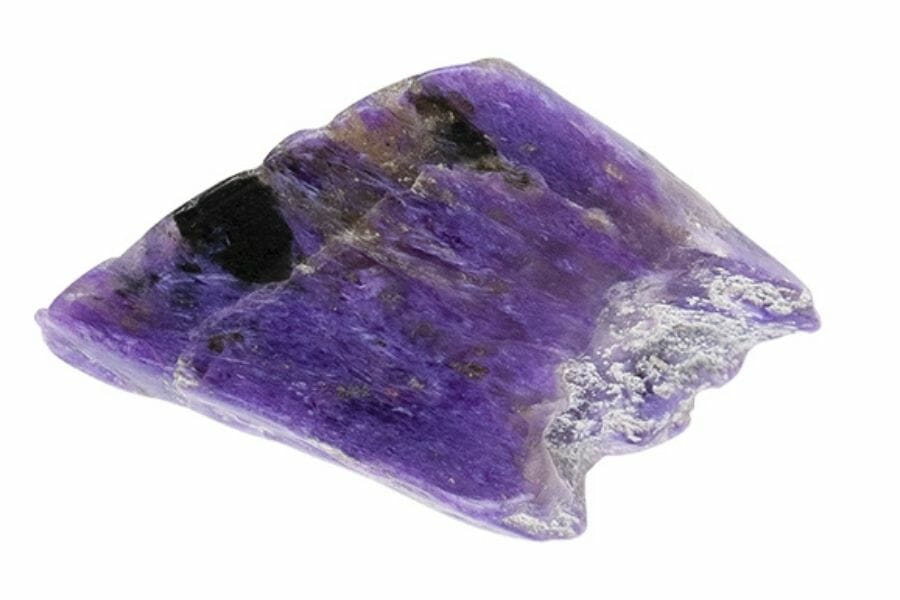
Charoite is a rare mineral discovered in the 1940s in the Sakha Republic of Russia. It is a gorgeous mineral that ranges from purple to lavender in color and has a unique swirling pattern.
Charoite can be cut and polished into cabochons, beads, and tumbled stones for jewelry making, as well as carved into figurines and other decorative items.
The discovery of charoite is credited to Russian geologist V.I. Vernovsky who first encountered this unusual stone near the Chara River that flows through the Sakha Republic.
It was not until 1978 that charoite’s full potential was realized, and it began to be used for ornamental jewelry pieces and other decorative objects. Since then, its popularity has grown steadily worldwide due to its unique beauty and rarity.
Fun Fact
The name Charoite is derived from the Charo River which is near where it was found.Where Charoites are found
Charoites are only found in one location, the Chara River region of Russia. It’s a unique mineral not found anywhere else on Earth, making it one of the rarest minerals ever discovered.
How you can identify a Charoite
Color
Charoite is a mineral known for its distinctive and intricate swirling patterns in lavender, purple, and mauve shades.
The brilliant purple hues are caused by rare earth elements and other minerals, giving charoite a unique and visually striking appearance.
Hardness
On the Mohs scale hardness, Charoite ranks at 5.5 to 6.5. This makes it a relatively soft stone compared to other minerals in the same category, such as quartz or glass.
Charoite is still considered durable for jewelry and other ornamental objects; however, it should be stored with care to prevent scratches or chips that can occur with rough handling.
Clarity
Charoite has a vitreous luster and can be transparent to translucent in clarity. Its unique appearance is due to inclusions such as pyrite and actinolite, which can impart a chatoyancy or schiller effect when polished.
Refractive index
Charoite has a refractive index of 1.494-1.498, which is on the lower end of the range of gemstone values. It has a higher birefringence than most stones, at 0.008-0.010, and a relatively low dispersion at 0.018-0.020.
Specific gravity
Charoite has a specific gravity of 2.6-2.8, which is considered heavy for a mineral. This means it’s heavier than most other minerals and will sink in water.
Creedite – Ca₃Al₂SO₄(F, OH)₁₀·2
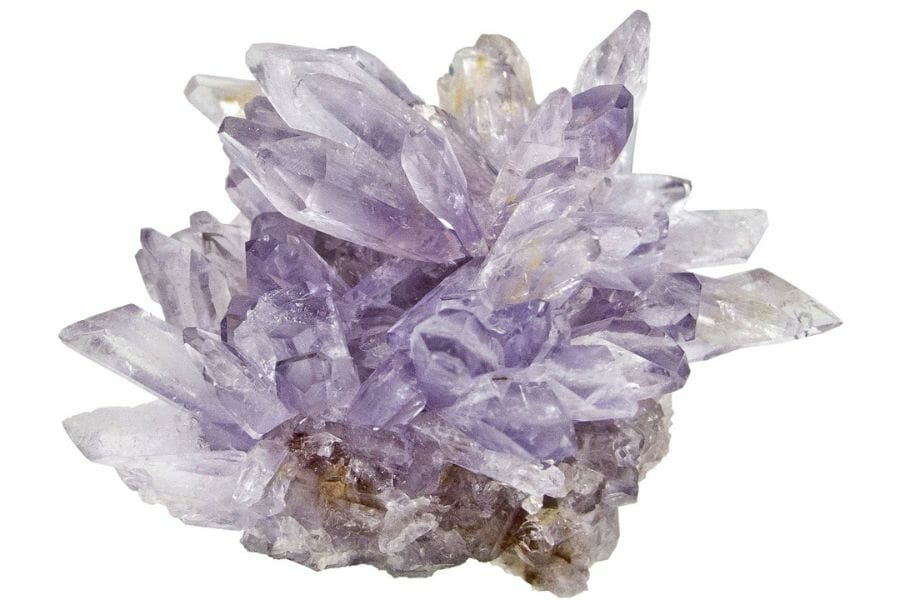
Creedite is a rare mineral that forms in arid climates, typically in clusters of prismatic crystals. It is composed of calcium, aluminum, and sodium. The name creedite comes from the Spanish word “credo,” which means “I believe.”
It was first discovered in 1901 by mineralogists at the University of Mexico, who named it after its discoverer, Mexican geologist Jose Maria de la Cruz Creede.
Creedite forms in arid environments and is known for its distinctive crystal formations and bright, sparkling appearance. Collectors prize it for its unique crystal formations and bright colors.
Despite its rarity, creedite is a mineral that the mineral-collecting community has widely recognized. It’s now considered one of the world’s most exciting and visually striking minerals.
Fun Fact
Creedite is believed to be a powerful stone for spiritual awakening and can help enhance meditation and communication with higher realms.Where Creedites are found
Creedite is found in many locations, including Mexico, Arizona, California, and Nevada. It has also been found in Russia and India.
How you can identify a Creedite
Color
Creedite is a beautiful mineral with various colors, including lavender, orange, and white. It often forms in clusters of prismatic crystals.
Hardness
Creedite has a hardness of 5 to 5.5 on the Mohs scale, which is considered fairly soft. It is not as hard as quartz or other minerals such as topaz, but it is still quite durable and can be used in jewelry and other decorative pieces.
Clarity
Creedite has a vitreous luster and a glassy, shiny appearance. Its transparency ranges from transparent to translucent, with the clearest specimens being transparent.
Refractive index
Creedite has an anisotropic refractive index, meaning that its refractive index differs when light passes through it in different directions.
21Its average refractive index ranges from 1.541 to 1.548, with the highest values measured when the light is perpendicular to the c-axis of the crystal structure.
Specific gravity
The specific gravity of creedite is 3.1-3.2, which is significantly higher than the average for most minerals. This high specific gravity is due to its composition of calcium, aluminum, and sodium sulfates, all relatively dense elements.
Creedite also contains small amounts of other elements, such as iron and magnesium, which can further increase its specific gravity.
Hackmanite – Na8Al6Si6O24(Cl2,S)
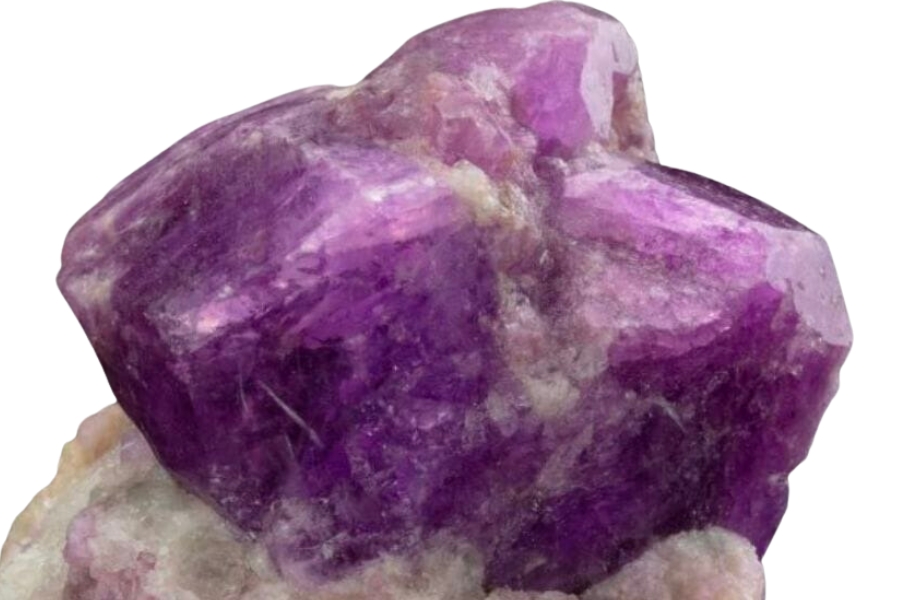
Hackmanite is a rare and unique form of sodalite. It is a sodium-rich variety of minerals and has an attractive pinkish-purple hue.
It was first discovered in Finland in 1868 by Swedish mineralogist Axel Hackman. Hackmanite is found in only a few places, mainly in Russia and Canada.
Its color varies from light to deep pink depending on the amount of calcium present within it. In some cases, it can display an opalescent sheen, making it highly sought after by collectors.
Hackmanite is typically cut into cabochons or beads and used for jewelry items such as necklaces, earrings, and rings.
Fun Fact
Hackmanite exhibits a rare property of reversible photoluminescence, meaning it changes color under ultraviolet (UV) light and reverts to its original color in the presence of sunlight or long-wave UV light.Where Hackmanites are found
Hackmanites are a rare mineral found mainly in Finland and other areas of Europe, including Sweden, Norway, Russia, and Germany.
How you can identify a Hackmanite
Color
Hackmanite is known for its color-changing properties, making it a vibrant and unique gemstone. Hackmanite can be green, yellow, or colorless in its original state, but it changes to pink, purple, or reddish-violet when exposed to ultraviolet light.
Hardness
Hackmanite is an unusual gemstone that is known for its hardness. It has a hardness of 6-7 on the Mohs scale, which is in the quartz range and more complex than glass.
Because of its hardness, hackmanite is a good material for jewelry creation because it can survive everyday wear and tear without easily scratching or chipping.
Clarity
The clarity of hackmanite can range from transparent to translucent, with some specimens exhibiting inclusions, or slight imperfections, that are visible to the naked eye.
These inclusions can form mineral veins, tiny bubbles, or other mineral deposits trapped within the gemstone during its formation.
Refractive index
The refractive index of hackmanite ranges from 1.50 to 1.54, which is relatively low compared to other popular gemstones such as diamond or sapphire.
This low refractive index, combined with its transparency, gives hackmanite a somewhat dull appearance compared to other minerals.
Specific gravity
The specific gravity of hackmanite ranges from 2.6 to 3.2, which is considered relatively high for a mineral. This density is due to its high concentration of sodium and calcium, making it one of the heaviest minerals in the sodalite group.
It also has a relatively low porosity, containing little or no air pockets inside the stone.
Kämmererite – Mg5Al(AlSi3O10)(OH)8
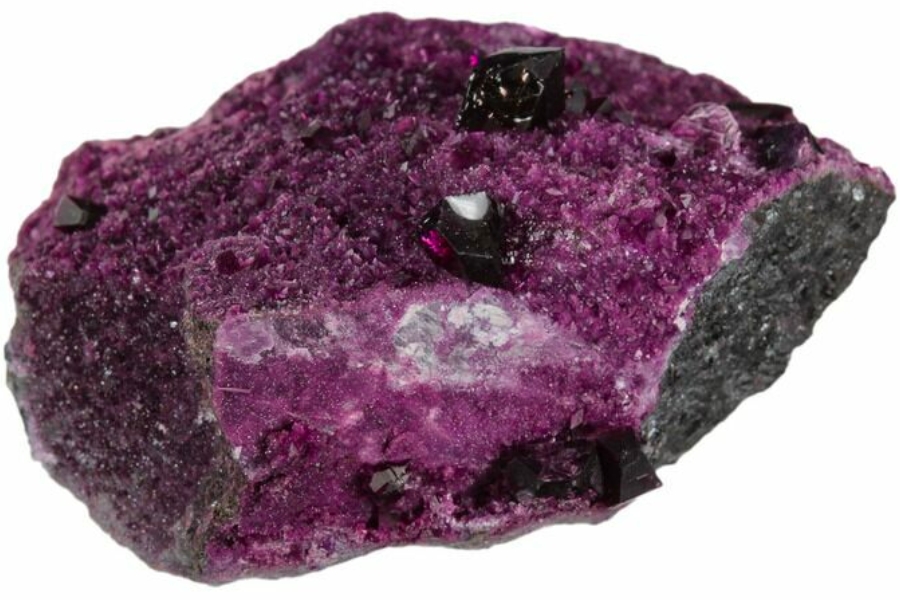
Kämmererite comes in a rare purple and pink variant. It’s a rare mineral first discovered in the Kola Peninsula in Russia.
In honor of August Alexander Kämmerer, a Russian “mountain chemist” who investigated the chemistry of crystals and their effects on the human body in the eighteenth century, kämmererite was given his name.
Kämmererite is an oxide of iron and manganese and belongs to the spinel group of minerals. It usually occurs as tiny crystals in pegmatite deposits or skarns associated with carbonate rocks.
Since its discovery, kammererite has been studied by many different researchers who have tried to determine its chemical composition and physical properties. Today it is still used for research purposes and as a collector’s item due to its rarity.
Fun Fact Chlorite, which is present in this gem, is what gives it its many colors, including purple, deep purple, pinkish purple, and others.
Where Kämmererites are found
Kämmererite is a rare mineral found in limited locations globally, including Greenland, Antarctica, Russia, and Canada.
How you can identify a Kämmererite
Color
Kämmererite is known for its striking and beautiful blue and violet hues. The intensity and saturation of the color can vary, ranging from pale blue to deep violet, creating a visually appealing mineral that is highly sought after by collectors.
The blue and violet tones of kammererite create a stunning contrast against its metallic luster, making it a fascinating mineral to observe.
Hardness
Kämmererite is a relatively hard mineral, with a Mohs hardness rating of 5.5 to 6. This means it can scratch minerals with a hardness of 5 or less but can be scratched by minerals with a hardness of 6 or higher.
Clarity
Kammererite is a translucent to opaque mineral with varying clarity depending on the specimen. Some specimens may display inclusions, cracks, or cloudiness, while others may have a clear, glass-like appearance.
Refractive index
Kämmererite has a moderate to high refractive index ranging from 1.71 to 1.75. The moderate to high refractive index of kämmererite contributes to its metallic luster and enhances the intensity of its blue and violet hues.
Specific gravity
Kämmererite has a relatively high specific gravity, which ranges from 3.6 to 3.8. Specific gravity is a measure of the density of a mineral compared to water.
The relatively high specific gravity of kämmererite makes it a relatively heavy mineral for its size and contributes to its solid feel when handled.
Purpurite – Mn3+(PO4)
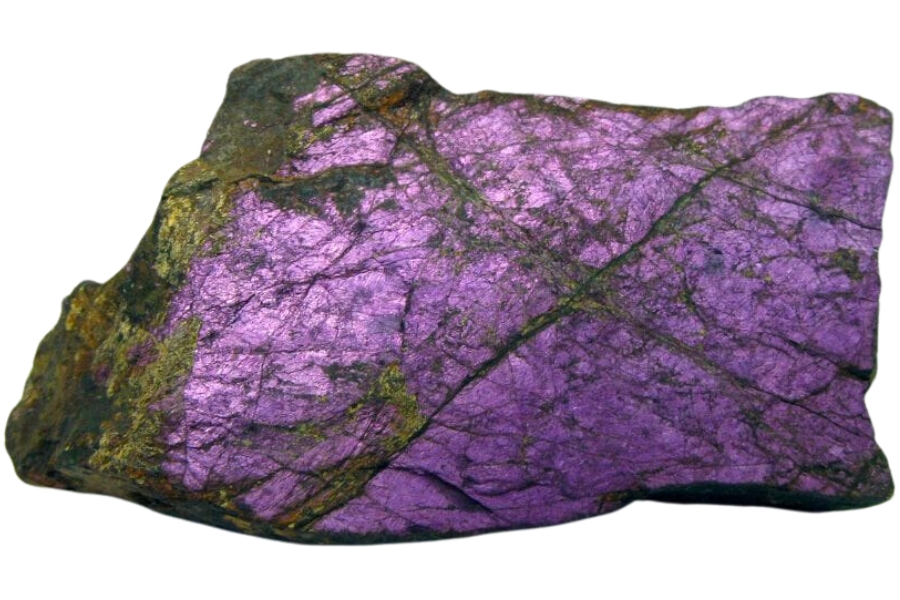
Purpurite is a scarce mineral first discovered in 1884 in South Africa. It is a deep purple-violet color commonly found as a secondary mineral in copper deposits.
Its name comes from its distinctive purple color, which resembles the purple robes worn by Roman Catholic cardinals. Purpurite has been used historically as a gemstone and found in jewelry dating back to the 1700s.
It’s believed that purpurite creates a strong spiritual connection to the wearer, allowing them to access higher levels of consciousness and intuition.
Today, it’s still a gemstone and crystal healing stone due to its energy properties that promote inner peace and clarity of thought.
Fun Fact
Purpurite is a modified form of the equally uncommon mineral, lithiophilite.Where Purpurites are found
Purpurites can be found in various locations, including France, South Africa, Namibia, Australia, and the United States.
How you can identify a Purpurite
Color
Purpurite is a beautiful, deep purple mineral that often has a slight pinkish hue. It is known for its unique color, which varies in intensity depending on the stone’s quality. The deeper the purple, the higher the grade of purpurite.
Hardness
Purpurite has a hardness rating of 4-4.5 on the Mohs scale, making it a relatively soft mineral. It is generally considered quite brittle and can easily be scratched with a fingernail or other household items.
Clarity
Purpurite is a translucent to opaque gemstone with a vitreous to greasy luster. It has moderate clarity and can sometimes appear cloudy due to inclusions.
Refractive index
The refractive index of purpurite is between 1.653 and 1.716, with a birefringence of 0.063.
This means that the speed of light passing through it will be different depending on the angle of incidence, resulting in double refraction and a change in the apparent orientation of an object seen through it.
Specific gravity
The specific gravity of purpurite is estimated to be between 4.1 and 4.9, depending on the sample. This places it among the heavier gemstones, which is unusual for a mineral that contains some lead.
The specific gravity range is due to other elements in the crystal structure, such as manganese and iron.
Spodumene – LiAlSi2O6
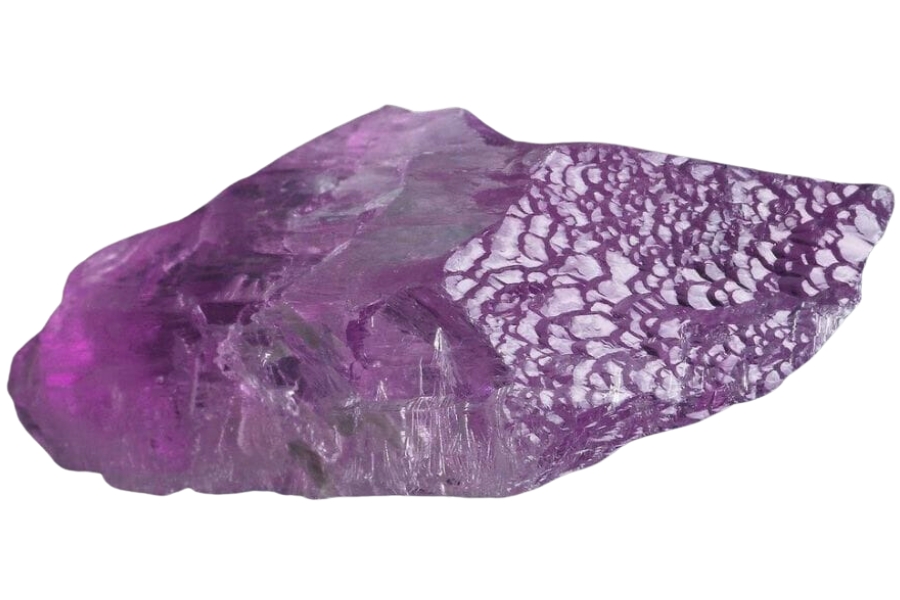
Spodumene is an important mineral found in pegmatites and mica schists. It’s typically a greenish to yellowish-green or pinkish-purple color.
This mineral was first described in 1800 by the Swedish naturalist Jöns Jacob Berzelius. It was named for its high potassium content, which gives it its unique properties.
Spodumene has been mined for centuries, particularly in Brazil and other parts of South America.
Today, it’s used as an industrial mineral in ceramics, glassmaking, and abrasives production. It’s also a gemstone for jewelry because of its unique coloration and clarity.
Fun Fact
The name spodumene comes from the Greek word spodumenos, which means "burnt to ashes."Where Spodumenes are found
Spodumene can be found in pegmatite deposits, igneous rocks that form when magma cools slowly deep underground. These deposits are typically found in dry, mountainous regions such as Nevada, Afghanistan, and Brazil.
How you can identify a Spodumene
Color
Spodumene is a mineral species that can occur in various colors, including yellow, green, pink, purple, and colorless.
The exact color of a spodumene specimen depends on the presence of impurities and the type of spodumene present. Pink and purple spodumene is found in lithium-poor deposits.
Hardness
Spodumene has a hardness of 6.5 to 7 on the Mohs scale of mineral hardness, making it a relatively hard mineral. This hardness allows it to resist scratching and abrasion to a certain degree, although harder materials can still scratch it.
Clarity
Spodumene can occur in many clarity levels, from transparent to translucent and even opaque. The clarity of a specimen depends on the presence of inclusions, fractures, and other internal features.
Some specimens may have few or no visible inclusions, while others may have more prominent internal features.
Refractive index
Spodumene is a type of mineral with a refractive index of 1.62-1.64, which is considered quite high compared to other minerals.
This means it bends light more than most other minerals, creating a higher level of optical dispersion and resulting in the mineral appearing more sparkly and lustrous than others.
Specific gravity
The specific gravity of spodumene ranges from 3.0 to 3.2, making it one of the heaviest minerals in the world. Its high density is due to its lithium aluminum silicate chemical composition, which gives it a much higher weight than other common minerals.
The specific gravity of spodumene can vary depending on the particular deposit and can be as high as 3.3 in some cases.
Spurrite – Ca5(SiO4)2(CO3)
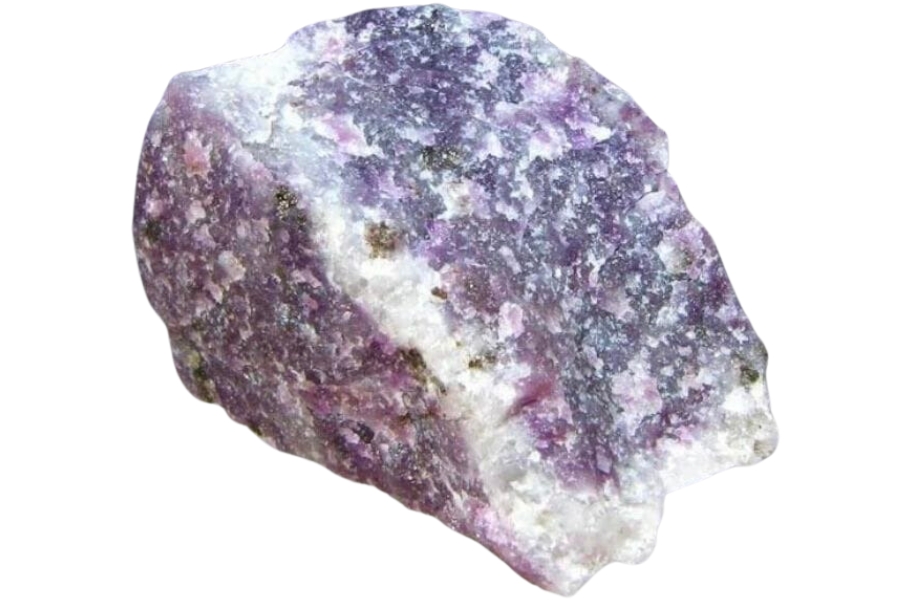
Spurrite is a rare mineral composed of magnesium, aluminum, and silicate. It’s known for its unique crystal formations, which can be elongated, fibrous, or radiating.
Spurrite is a relatively rare mineral and is highly sought after by collectors due to its beauty and rarity. It’s also of interest to geologists, as it provides insights into the conditions and processes of formation in the upper mantle.
It’s mainly used as an ornamental stone in jewelry due to its beautiful color and unique crystalline structure. Spurrite can also be used for industrial purposes such as abrasives and polishing compounds.
Fun Fact
It was named after American geologist Josiah Spurr, which explains the name's significance.Where Spurrites are found
Scotland, Ireland, New Zealand, New Mexico, Montana, and California are some locations where spurrite is found.
How you can identify a Spurrite
Color
Spurrite is a beautiful gemstone with a unique combination of colors. It has an intense, deep blue color that is sometimes described as navy or midnight blue. It may also have hints of green, yellow, and purple with a subtle sparkle.
Hardness
Spurrite has a hardness rating of 5.5 to 6 on the Mohs Hardness Scale, making it a relatively hard mineral. Its hardness is comparable to the hardness of glass and quartz but not as hard as corundum, topaz, or diamond.
Clarity
Spurrite has a vitreous to resinous luster with a transparent to translucent clarity grade. Spurrite also displays an exciting chatoyancy effect when cut into thin slices and viewed under light, which can give it a unique appearance.
Refractive index
The refractive index of spurrite is relatively high, measuring between 1.87 and 2.01, depending on the wavelength of light and the direction in which it travels.
It has an anisotropic refractive index, meaning that its optical properties vary depending on the orientation of the light relative to the crystal structure.
Specific gravity
Spurrite has a specific gravity of 2.8-3.1, significantly higher than the average specific gravity of minerals (2.5-3).
This is due to its high density, caused by its zinc and manganese sulfide chemical composition, which makes it heavier than most other minerals.
Stichtite – Mg6Cr3+2(OH)16[CO3] · 4H2O
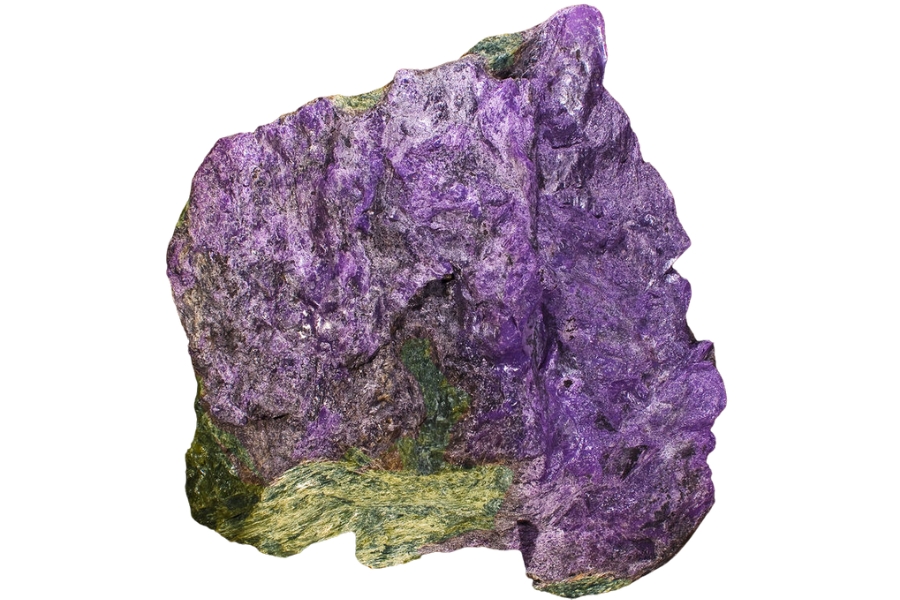
Stichtite is composed of magnesium chromium silicate and has a unique pinkish-purple color. Collectors highly prize Stichtite for its rarity and its unusual patterns. It’s also used in jewelry due to its intense color and fascinating shapes.
In addition, stichtite has been used to create sculptures, figurines, and other decorative objects. Stichtite is believed to have healing properties that help with emotional balance and spiritual growth.
This beautiful stone has been around for centuries, but only recently has it gained popularity among collectors and jewelry makers alike.
Fun Fact Stichtite often forms with the Green Serpentine stone found in Tasmania, and is called Atlantasite.
Where Stichtites are found
Stichtites can be found in Stichtite Hill, near Zeehan, Tasmania, Australia. They are a rare mineral species and can also be found in other locations in Australia, New Zealand, and some parts of Africa.
How you can identify a Stichtite
Color
Stichtite is a pale green to pinkish-purple mineral, often with a mottled or banded appearance. Its color is caused by trace amounts of chromium and nickel in the crystal structure.
Hardness
Stichtite has a low to moderate hardness, with a value of 2.5 to 4 on the Mohs scale of mineral hardness. This makes it relatively soft compared to other minerals and easily scratched.
Due to its softness, stichtite is typically unsuitable for jewelry or other applications where it may be subjected to abrasion or impact.
Clarity
Stichtite is generally translucent to opaque, with varying degrees of transparency depending on the quality and size of the specimen. The mineral can display inclusions, fractures, and other internal features, affecting its clarity.
Refractive index
Stichtite has a refractive index of 1.51-1.53, slightly lower than quartz. It exhibits a birefringence of 0.01-0.03 and is optically isotropic, meaning it does not exhibit double refraction when light passes through it.
Stichtite has an ordinary and extraordinary index of refraction that is nearly the same, making it a relatively weak optical material compared to other gemstones such as quartz and diamond.
Specific gravity
The specific gravity of stichtite is 2.88 to 3.05, which is slightly higher than the average for most minerals. This means it is a bit denser than many other minerals and will sink in water more quickly than those with lower specific gravity.
Stichtite is composed of hydrated magnesium chromium silicate, and its high specific gravity gives it a heavy feel when handled.
Sugilite – KNa2Fe3+2(Li3Si12)O30
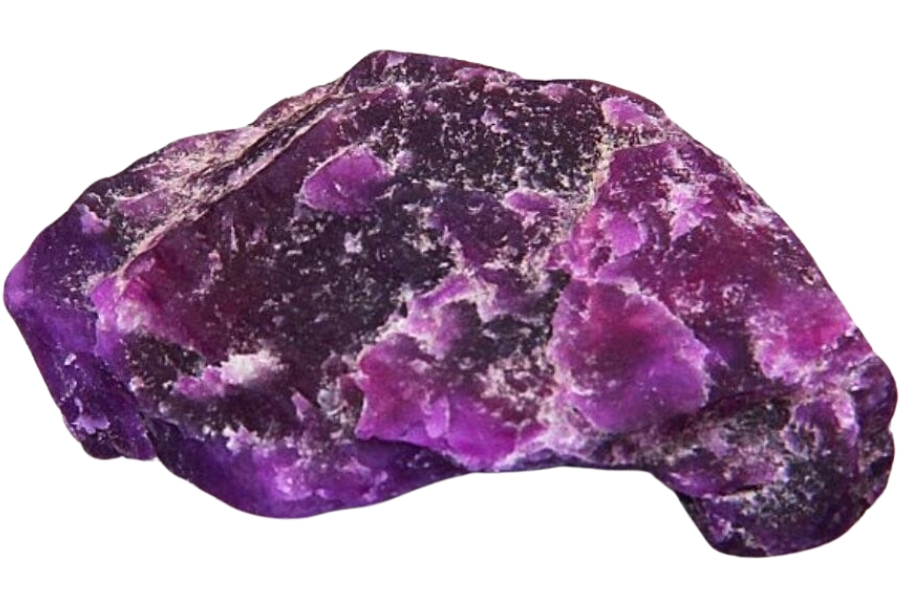
Sugilite is a relatively rare mineral, first discovered in Japan in 1944 by a Japanese scientist, Ken-ichi Sugi. It is also known as “Lavulite” due to its deep purple color.
In the 1970s, it was found to be a very powerful stone for healing and spiritual protection. It is composed of sodium, calcium, and manganese silicate and forms in large masses of varying shades of deep purple or lavender.
Sugilite has become increasingly popular due to its unique beauty and powerful metaphysical properties. It has been used to help people open their hearts, increase their self-esteem, and bring peace and harmony into their lives.
Sugilite is also believed to be an excellent stone for assisting people in connecting with their higher selves, and the Divine source of all life.
Fun Fact Royal Lavulite and Royal Azel are other trade names for Sugilite.
Where Sugilites are found
Sugilites are a rare mineral species found in several locations worldwide, including South Africa, Canada, Russia, and Japan.
The largest deposit of sugilite is found in the Wessels Mine, located in the Kalahari Manganese Field in the Northern Cape Province of South Africa. Other significant deposits have been found in Canada and Russia.
How you can identify a Sugilite
Color
Sugilite is a deep, purplish-pink stone with a unique combination of hues. Its color ranges from pinkish-purple to lavender-purple, and it often displays mottled patches of white, yellow, and black.
Hardness
Sugilite is a relatively hard mineral with a hardness of 5.5 to 6 on the Mohs scale. It’s harder than many of the more common minerals such as quartz, calcite, and gypsum but not as hard as topaz or diamond.
Since hardness depends on the direction it is measured in, sugilite can appear softer in some directions than others.
Clarity
Sugilite is a relatively rare gemstone with a moderate to good clarity rating. It is usually opaque, with some pieces appearing translucent when held up to the light.
Refractive index
Sugilite has a refractive index of 1.571-1.579, which is average for a gemstone and slightly lower than the refractive index of quartz or other gemstones.
It has a unique absorption spectrum that is not shared by any other gemstone, with strong absorption at 690 nm and 830 nm wavelengths.
Specific gravity
Sugilite has a specific gravity of 2.9 to 3.2, which is relatively high for a gemstone. This means that it is heavier than most other gemstones but lighter than the average for minerals in general.
It also means that it is denser than most other gemstones, as its weight is concentrated in a smaller volume.
Taaffeite – Mg3Al8BeO16
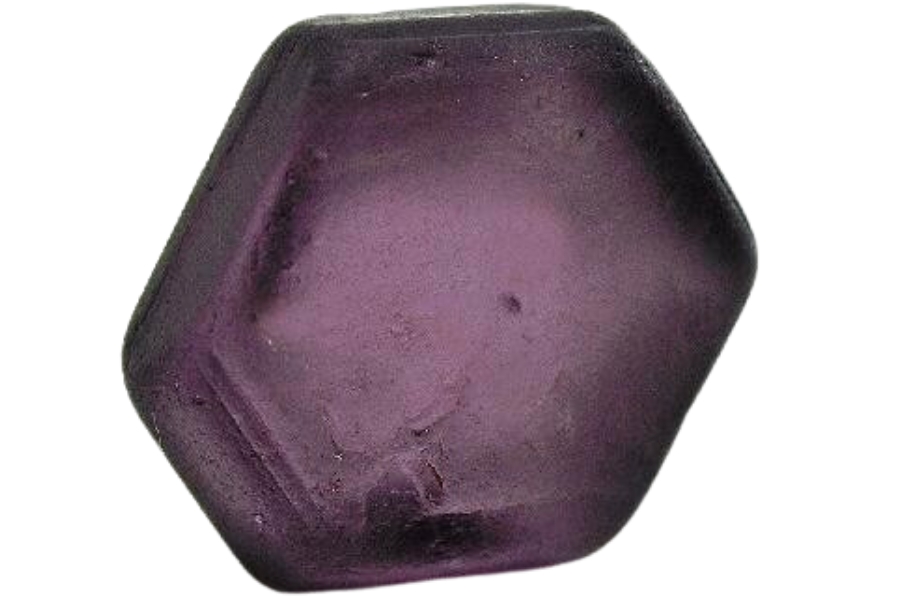
Taaffeite is a rare mineral discovered in 1945 by Count Edward Charles Richard Taaffe of Ireland. It’s a rare and fascinating gemstone that has captivated the world since its discovery.
It’s one of the rarest gems in the world, with only a few hundred specimens known to exist. Its unusual violet-blue color and rarity make it highly sought after by collectors.
Taaffeite’s composition is beryllium magnesium silicate, and its crystals are often found embedded within mica schist or marble matrixes. It’s usually found in small sizes, with its largest known crystal measuring only 4 cm across.
It’s believed to have formed as a result of metamorphic processes which occurred over millions of years.
Fun Fact
Taaffeite is the only mineral known to have been identified from its faceted form before it was found in natureWhere Taaffeites are found
Taaffeite has since been found in Sri Lanka, Tanzania, Burma, China, and Madagascar. It’s also occasionally found in meteorites.
How you can identify a Taaffeite
Color
Taaffeite is a rare mineral notable for its striking coloration, ranging from purplish-red to bluish-violet.
The exact shade of color can vary depending on the specimen, with some specimens displaying a more intense, vibrant color while others may appear more muted.
Hardness
Taaffeite has a hardness of 8 on the Mohs scale of mineral hardness, making it a relatively hard mineral. This hardness allows it to resist scratching and abrasion more than softer minerals.
Clarity
Taaffeite is generally transparent to translucent, with varying degrees of clarity depending on the quality and size of the specimen. It can display inclusions, fractures, and other internal features, affecting its clarity.
Refractive index
The refractive index of taaffeite ranges from 1.744 to 1.753, which is relatively high compared to other minerals and gemstones.
Specific gravity
Taaffeite has a specific gravity of 3.84, considered heavier than the average gemstone. It’s denser than most minerals and heavier than quartz or diamond.
Taaffeite has a higher specific gravity than other beryllium minerals, such as beryl and emerald. It’s also one of the heaviest minerals known to man.

